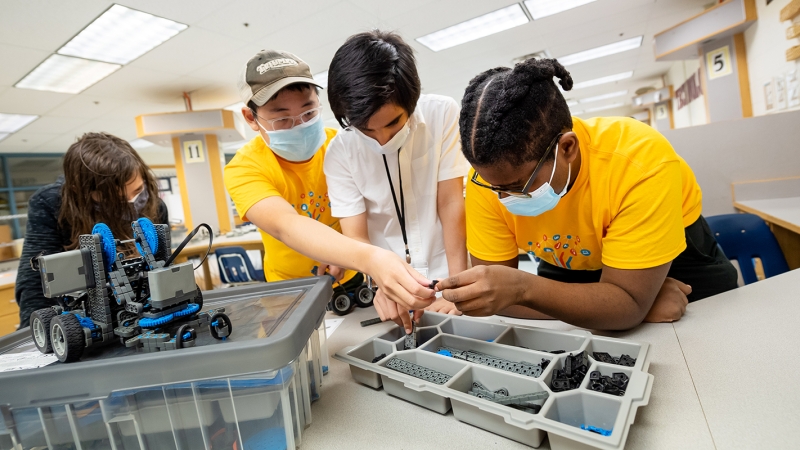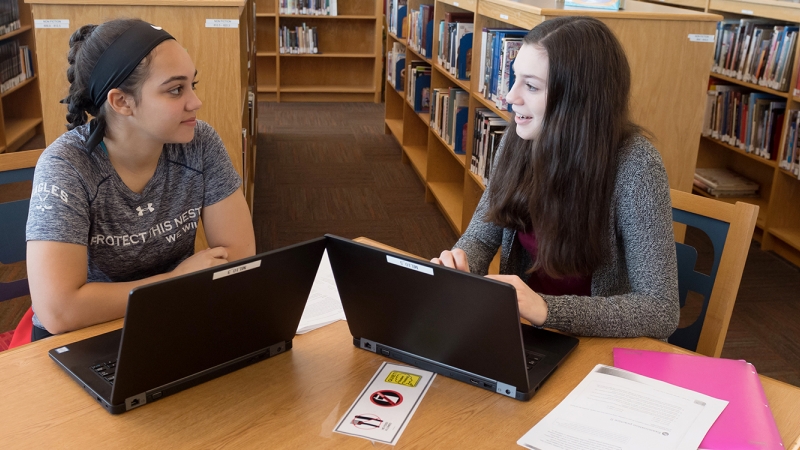
Computer Science in FCPS
Computer Science: empowering students to lead in today’s data-rich and interconnected world.
Computer Science is Good for ALL Students from Preschool through Grade 12
1. Modern-day careers use computer science
Computer science (CS) prepares students for all types of careers, even careers that do not involve programming. Through CS, students learn to problem solve and create with technology.
2. Critical thinking and creating are at the core of computer science.
Computer science (CS) engages students in divergent and computational ways of thinking. Through CS, students imagine and create new ways of solving problems.
3. Computer science for ALL removes barriers and increases equity.
Virginia is leading the way by requiring that all students learn computer science beginning in elementary school.
Computer Science (CS)
Computer science is the study of how to use computers to learn, explore, create, and solve problems. It is more than coding and programming. Computer science equips students with the knowledge and skills to solve problems in new ways. Students learn that their ideas matter and that they can solve complex, open-ended problems.
Computational Thinking (CT) in Computer Science
Computational thinking (CT) is a problem-solving process. For example, students learn to:
- Break a complex problem into smaller parts (Decompose)
- Look for patterns and simplify complexity (Generalize and Abstract)
- Persist and try again (Iterate)
- Sequence step-by-step solutions (Algorithms)
- Organize data (Analyze data)
- Identify and fix problems in a solution (Debug)
- Use and create models and simulations (Modeling)
CT existed before computers and in all subject areas. Today, it is possible to use computational thinking to create instructions that a computer can follow.
Coding in Computer Science
Code is a language that students can use to create or to have computers automate solutions. Example elements of coding:
- Repeating patterns are loops.
- A sequence of steps is an algorithm.
- Identifying and fixing problems in code is debugging.
“Coding (or computer programming) is a new type of literacy. Just as writing helps you organize your thinking and express your ideas, the same is true for coding.” - Scratch Jr.
Below are free online coding resources for students. These sites are used to support students and families during in the December Hour of Code initiative in FCPS with the hope that one hour will lead to more coding-based learning opportunities.
- Hour of Code
- Code.org
- App Lab (ages 13+)
- Scratch Jr. (available as an app only)
- Scratch
- Microsoft: MakeCode
- Google for Education: CS First
- Kodable
To learn more about how FCPS selects and approves these and other digital resources for use in FCPS, visit Digital Resources in FCPS.
What Students Can Do with Computer Science
Students apply computer science to design and create computer-based solutions that express an idea or solve a problem. Apps, programs, and simulations are a few examples. The possibilities are endless. For example, while in high school, an FCPS student used computer science to invent a new way to diagnose cancer.
Computer Science Opportunities in FCPS
Computer Science (CS) takes place in many different settings. Classrooms, labs, before- or after-school programs and clubs are a few examples.
Elementary teachers integrate CS and Computational Thinking (CT) into instruction. History, English, fine arts, mathematics, science, and physical education all connect to CS. For example, students can create a story setting, characters, and plot using scratch.
At the secondary level (grades 6-12), FCPS offers computer science elective courses. Explore course offerings in the Career Technical Education (CTE) and Mathematics programs.
STEAM supports computer science integration in FCPS.
Computer Science without Computers
 Students develop a deeper understanding of CS without digital technology using "unplugged” activities.
Students develop a deeper understanding of CS without digital technology using "unplugged” activities.
STEAM makes microcontrollers, circuitboards, and robotics available for K-12 educators to use.
Students in secondary CS electives also access technology through FCPSOn.
Connections to FCPS Portrait of a Graduate (POG) skills
 Computer Science (CS) fosters an inclusive culture and helps students develop the FCPS Portrait of a Graduate skills.
Computer Science (CS) fosters an inclusive culture and helps students develop the FCPS Portrait of a Graduate skills.
In computer science, students design and create with diverse users in mind.
- Students develop as communicators when they consider perspectives different from their own.
- Students develop as ethical and global citizens as they explore social, economic, and cultural contexts.
 Students create in CS to express ideas and design solutions that benefit the community or are personally relevant.
Students create in CS to express ideas and design solutions that benefit the community or are personally relevant.
- Students ask questions, and apply critical and creative ways of thinking.
- Students collaborate and incorporate feedback from classmates to debug and improve their designs.
- Students explore careers, persist through challenges, and develop resilience and goal directed skills.
STEAM and Computer Science Actively Advance Equity
STEAM and computer science empower students from an early age to create and innovate. Students use computer science and engineering practices to explore real world problems and design solutions.






